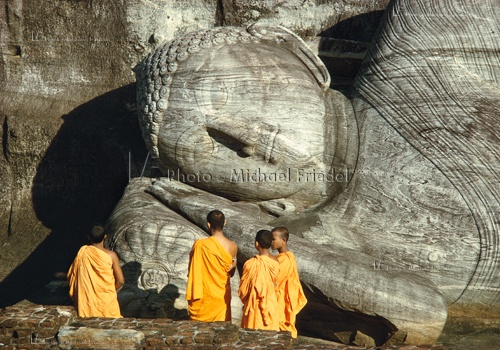SRI LANKA - BUDDHAS ISLAND


WORDS © MARION FRIEDEL
Beaches to dream about, tea-plantations and rice-terraces set in primeval rain-forest, and botanical gardens with the most beautiful flowers of the tropics. In the midst of this varied landscape lie the monuments of a high culture dating back thousands of years - temples, ruined cities and sculptures, largely in the Buddhist tradition. Starting in the 5th century B.C., settlers from northern India, led by King Vijaya, migrated to Sri Lanka and thus began Singhalese history. Soon afterwards, they were followed by the Tamils from southern India. In the 2nd century B.C. Buddhism arrived on the island from southern India. With the transplanting of the “Tree of Enlightenment” from India to Sri Lanka, Buddhism almost completely lost its original roots in India. In the centuries that followed there was a succession of Tamil and Singhalese kingdoms, ruled from magnificent temples. The Singhalese established Buddhist realms, those of the Tamils were Hindu. For long periods both groups struggled for dominance in the country, while at other times they lived at peace with each other and intermarried. In the course of these conflicts the Tamils eventually became concentrated in the north and the Singhalese in the south. No visitor to Sri Lanka can avoid encountering two names: one is Anuradhapura, the first capital of five centuries before Christ, and for more than a thousand years it has been the cosmopolitan centre of Sri Lanka and religious focal point of the island. In its ruins there are excavations of monumental stonemasons’ work, relics of palaces and temples - works of art that are comparable in their beauty with the pyramids of Egypt. The second name is Polonaruwa, a royal city since the 11th century, which after a heyday lasting 200 years, reverted to the green of the jungle. Today, thanks to excavation by the British, it is a world-class open-air museum with wonderful evidence of the “Singhalese renaissance”. Since 1982 this archaeological park has been a UNESCO World Heritage site. The remains of immense stupas and temples with countless figures of the Buddha, as well gardens, parks and palaces and the diverse buildings of an extensive city, all make this a major attraction for tourists. Sri Lanka offers many interesting excursions and much that makes a change from the normal beach holiday.
SRI LANKA - BUDDHAS ISLAND
WORDS © MARION FRIEDEL

WORDS © MARION FRIEDEL
Beaches to dream about, tea-plantations and rice-terraces set in primeval rain-forest, and botanical gardens with the most beautiful flowers of the tropics. In the midst of this varied landscape lie the monuments of a high culture dating back thousands of years - temples, ruined cities and sculptures, largely in the Buddhist tradition. Starting in the 5th century B.C., settlers from northern India, led by King Vijaya, migrated to Sri Lanka and thus began Singhalese history. Soon afterwards, they were followed by the Tamils from southern India. In the 2nd century B.C. Buddhism arrived on the island from southern India. With the transplanting of the “Tree of Enlightenment” from India to Sri Lanka, Buddhism almost completely lost its original roots in India. In the centuries that followed there was a succession of Tamil and Singhalese kingdoms, ruled from magnificent temples. The Singhalese established Buddhist realms, those of the Tamils were Hindu. For long periods both groups struggled for dominance in the country, while at other times they lived at peace with each other and intermarried. In the course of these conflicts the Tamils eventually became concentrated in the north and the Singhalese in the south. No visitor to Sri Lanka can avoid encountering two names: one is Anuradhapura, the first capital of five centuries before Christ, and for more than a thousand years it has been the cosmopolitan centre of Sri Lanka and religious focal point of the island. In its ruins there are excavations of monumental stonemasons’ work, relics of palaces and temples - works of art that are comparable in their beauty with the pyramids of Egypt. The second name is Polonaruwa, a royal city since the 11th century, which after a heyday lasting 200 years, reverted to the green of the jungle. Today, thanks to excavation by the British, it is a world-class open-air museum with wonderful evidence of the “Singhalese renaissance”. Since 1982 this archaeological park has been a UNESCO World Heritage site. The remains of immense stupas and temples with countless figures of the Buddha, as well gardens, parks and palaces and the diverse buildings of an extensive city, all make this a major attraction for tourists. Sri Lanka offers many interesting excursions and much that makes a change from the normal beach holiday.
SRI LANKA - BUDDHAS ISLAND
WORDS © MARION FRIEDEL
